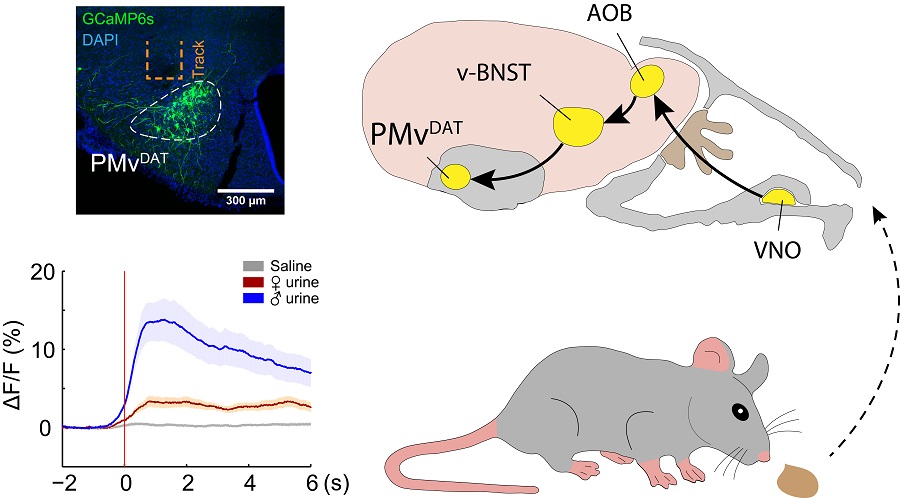Time:2020-09-21
A recent study published in Neuron entitled “Specific hypothalamic neurons required for sensing conspecific male cues relevant to inter-male aggression” describes a novel neural circuit for detecting male pheromone cues pertaining to inter-male aggression. This work was performed by researchers in Dr. XU Xiao-Hong’s Lab at the Institute of Neuroscience, State Key Laboratory of Neuroscience, Center for Excellence in Brain Science and Intelligence Technology of the Chinese Academy of Sciences.
Innate social behaviors are crucial for the propagation of a species. Yet, before launching any consummatory actions, animals need to first integrate sensory information to determine the sex of the interacting conspecifics. For example, males mate towards females but attack other males. Previous studies have shown that when the olfactory vomeronasal organ (VNO) was disabled by knocking out the gene encoding transient receptor potential cation channel, subfamily C, member 2 (trpc2), male mice showed diminished inter-male aggression and increased mating behaviors towards both male and female intruders. This indicates that a mouse’s ability to discern the sex of a conspecific critically depends on olfactory information from the VNO.
Recently, a number of studies have established that the hypothalamus plays an important role in the regulating innate social behaviors such as mating and aggression. But, how these hypothalamic neurons integrated sex information from the VNO to promote appropriate behavioral outputs remains largely unknown.
Using calcium transients recording in behaving mice, the authors found that a group of dopamine transporter (DAT) positive neurons in the ventral premammillary nucleus (PMvDAT) responded strongly when a male mouse sniffed male urine, but not urine from castrated male or female mice, or newborn mice, or rats. When they inhibited the PMvDAT neurons by chemo-genetics, the males lost their ability to recognize male urine and at the same time showed reduced attack behaviors towards a male intruder. Conversely, activating PMvDAT neurons increased the aggressive behaviors towards male intruders. Next, the authors used trpc2 knockout mice to specifically destroy the VNO signaling. They found that the response of PMvDAT neurons to male urine in knockout males decreased significantly.
Furthermore, using virus tracing, calcium recording and chemo-genetics, the authors found that male-relevant olfactory information was relayed via the bed nucleus of ventral stria terminalis (v-BNST) from the VNO to PMvDAT neurons. Taken together, these results demonstrate a critical role for PMvDAT neurons in encoding male conspecific information relevant to inter-male aggression. These results provide crucial insights into the neural circuit mechanism underlying sex specific olfactory information processing and regulation of sexually dimorphic social behaviors.
This work was published online in Neuron on September 21, 2020. It was completed by graduate student CHEN Aixiao, under the supervision of Dr. XU Xiaohong, with tremendous help from YAN Jingjing, ZHANG Wen, WANG Lei, SONG Nan, Dr. ZHU Shujia, Dr. XU Chun et al. This work was supported by the National Natural Science Foundation of China, Shanghai Municipal Government, and Chinese Academy of Sciences.

Figure legend: The VNO dependent neural circuit for the male cues transduction and aggression regulation. (Image by CEBSIT)
AUTHOR CONTACT:
XU Xiaohong
Center for Excellence in Brain Science and Intelligence Technology of the Chinese Academy of Sciences, Shanghai, China.
E-mail: xiaohong.xu@ion.ac.cn
 附件下载:
附件下载: